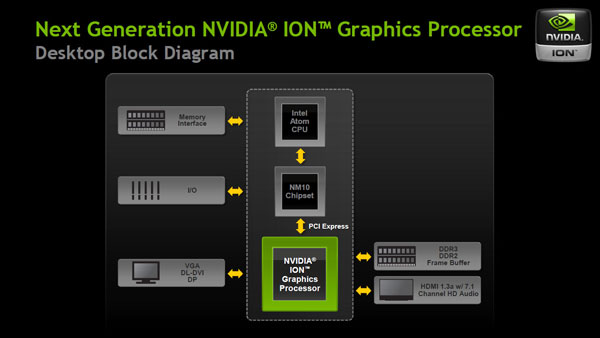New Driver Enables Smooth 1080p Flash Playback on NVIDIA NG-ION
by Anand Lal Shimpi on June 10, 2010 10:15 AM EST- Posted in
- GPUs
- Flash GPU Acceleration
- Next Generation ION
- ZOTAC
- NVIDIA
Last month I reviewed Zotac’s first Next-Generation ION nettop, the ZBOX HD-ID11. The chassis and feature set haven’t really changed much since the ION1 based ZBOXes, the only real difference is the HD-ID11 has Pine Trail and NVIDIA NG-ION inside. Unfortunately, in some cases, that’s not exactly an upgrade over the previous platform.
The original ION platform was a chipset and integrated graphics solution in a single package that stemmed off the Atom CPU. For a bunch of licensing reasons I described here, NVIDIA wasn’t allowed to build a similar chipset for the new Pine Trail Atom platform and thus had to come up with another solution. The next-generation ION now branches off Intel’s Pine Trail chipset, typically via a single PCIe 1.0 lane offering only 250MB/s of bandwidth to/from the chipset.

This results in a bandwidth bottleneck that can make bandwidth intensive GPU operations (e.g. 3D gaming) worse than the original ION. I suspect most folks don’t buy ION systems to game on them, so the bigger concern is another bandwidth intensive GPU operation: Flash video acceleration.
When you play back a GPU accelerated Flash video stream using Flash 10.1 on a Next Generation ION system the frames are sent to the GPU for decoding but then sent back to the CPU for compositing and finally copied back to the GPU’s frame buffer for display. In the Next Generation ION this happens over the meager PCIe 1.0 x1 interface. That’s thankfully bandwidth enough to decode, composite and display lower resolution Flash video, but not enough for 1080p.
Using current drivers if you try to play a 1080p YouTube HD stream on a Next Generation ION you’ll drop frames because of this bandwidth limitation. It gets worse if you decode and play the stream full screen at a 1080p desktop resolution. As I pointed out in my Next Generation ION review, even playing 480p Hulu content scaled up to 1080p dropped frames. It’s a real problem.

There is an obvious solution: do the entire process on the GPU itself, thus avoiding the copying back and forth over the PCIe x1 connection. NVIDIA told me this was possible, but it required a driver update. I now have that driver update: version 257.29.
The driver isn’t publicly available, although NVIDIA is shooting to have a public beta on June 28th with a WHQL release sometime in July.
I tested the driver with the latest Adobe Flash 10.1 beta (release candidate 7) and the NVIDIA press preview driver I mentioned above. I fired up YouTube in Chrome and picked a 1080p clip.
CPU utilization before and after the updated driver remains the same at around 15 - 20% of the Atom D510’s four threads. But this isn’t a CPU utilization problem. Using the current public driver the 1080p stream is unwatchable at full screen, the system drops a ton of frames. Using the updated driver? Smooth as butter.

It’s not all good news though. The frame rate will drop the minute you move your mouse and reveal the playback controls. That compositing still happens on the CPU. In fact anything that appears over the video kills frame rate. You can stop the playback controls from coming up by simply not moving your mouse, but a YouTube ad appearing over the video is less predictable.
Hulu continues to be a problem. Even a 360p video scaled up to 1080p will drop frames with the new driver. NVIDIA is aware of the issue and is working on it. To NVIDIA’s credit, Hulu has always posed problems for GPU acceleration ever since the Flash 10.1 betas hit.
The new driver definitely makes things better and it looks like NVIDIA is committed to improving the experience even further. But at this point, the original ION is still better for Flash video playback. If you’re using the NG-ION as a more traditional HTPC, playing files stored on your network and not streamed in a Flash movie then you’re of course fine. Read our Zotac ZBOX HD-ID11 Review for more on how the Next Generation ION performs in HTPC and other scenarios.










27 Comments
View All Comments
BBMW - Thursday, June 10, 2010 - link
I'm considering getting a nettop to hook up as a secondary computer/HTPC on my plasma panel. I was waiting for the Pine Trail platform to mature. But is it just hamstrung by Intels restrictions, and should I just get a last generation Atom based nettop, and not even deal with Pine Trail?LoneWolf15 - Thursday, June 10, 2010 - link
You're better off building something small off of a mini-ITX board. Even dual-core Celerons make all of this a non-issue, and you get a bit of upgradeability.Zotac makes Socket 775 and even 1156 mini-ITX boards, as do a couple of other vendors.
RandomUsername3245 - Thursday, June 10, 2010 - link
I doubt a dual Celeron can scale a 480p Hulu video to 1080p. A few months ago my 1.8Ghz Core2Duo (maybe an E4300) could not do that job smoothly. Hulu video is a CPU-hog, or at least it was in 2009...evilspoons - Thursday, June 10, 2010 - link
A dual Celeron may not be able to do it on its own, but a dual Celeron with the proper video card can.I have a Pentium Dual-Core E2200, which isn't exactly a speed demon. 720p h264 isn't totally smooth all the time in "regular" playback mode.
..but it's got a Geforce 9300 on the mainboard and when the correct drivers are installed, XBMC (under Linux) can do full 1080p scaling/playback with only about 15% CPU usage, and I suspect part of that 15% is my Bittorrent program.
I think the point is the mini-ITX solution will allow you to have a video card that isn't connected by a retarded x1 link, but a more reasonable x8 link or so.
Voo - Thursday, June 10, 2010 - link
So he should get a better CPU.. because he still needs to use a GPU for video playback? Since the old ion could handle flash/decoding without problems, I don't see why spending more money, getting a larger system with more heat, but the exact same attributes (i.e. being able to decode 1080p video) is a good idea.therealnickdanger - Friday, June 11, 2010 - link
I think he meant that a Zotac board (w/Ion-like 9300 IGP) using a dual-core Celeron would be a much better system. I would have to agree. The NVIDIA 9300/9400 GPUs can do 1080p video of all flavors with the newest drivers and Flash 10.1.Even in the review, it is stated that the system chugs on 1080p Flash whenever the cursor or video controls appear on screen. The extra CPU power should alleviate or eliminate stuttering in those cases... as well as provide a much more robust computing experience for all other tasks... even play games at decent fram rates.
Personally, I believe the Atom is good for one thing only: quiet, low power servers.
Voo - Friday, June 11, 2010 - link
Yeah but the old ION plattform had no problem with flash.No idea what anyone would want with the "new improved" version, since it can't even get the work done the old ion could handle..
mindless1 - Friday, June 11, 2010 - link
Patience, there was a time when early drivers for 1st-gen Ion weren't 100% either. Why does everyone assume they need to jump on new tech the first day it appears?taltamir - Saturday, June 12, 2010 - link
get an AMD CPU + integrated mobo on an mATX package... it is tiny, and it significantly faster for everything.The Atom is a cellphone class CPU. Intel never imagined anyone would build computers out of it, and for just a few bucks more you can get so much more in terms of performance.
mindless1 - Friday, June 11, 2010 - link
I had an o'c E2180 (dual core "Pentium" 65nm(?) @ 3GHz now slower than dual core celerons oc'd and it upscaled and plays 1080P H.264 fine with a 7600GT which only has partial, non-HD decoding. Just about any video card in the last 3 generations should do fine with a dual core CPU from either camp running at 2.5 GHz or better, and providing your Flash version is new enough to support GPU offloading it should be sufficient for that too unless you have a system misconfiguration.